Whether you’re a hotelier looking to maximize your property’s online visibility or a technical specialist in the hospitality tech industry, you’ve probably encountered the concept of a booking extranet. This tool plays a pivotal role in optimizing booking management and revenue strategies.
This article details the key features and advantages of a booking extranet. We'll also show you the main difference between a channel manager and an extranet and review the notable OTA extranets.
What is OTA extranet?
In general terms, an extranet is a private network that provides authorized access to internal information to a defined group of external stakeholders.
In the hospitality industry, a booking extranet, also called an OTA extranet, refers to the admin panel, where hoteliers can manually manage all information about their properties displayed on a particular OTA website: availability, rates, bookings, and other data. Each accommodation provider uses a unique login and password to access the extranet.
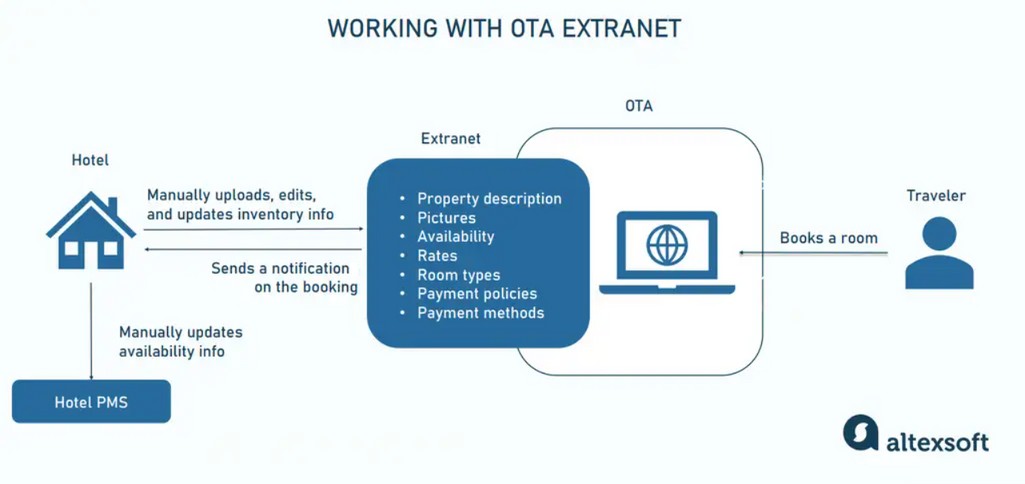
Interactions with an OTA extranet
Interacting with the extranet includes several essential operations.
Registration. When starting a partnership with an OTA, a hotel registers on the OTA website via the extranet. This involves
- entering essential property details,
- uploading photos,
- setting up room types and rates,
- deciding on payment policies and methods, and
- agreeing to the OTA's terms and conditions.
This ensures that the agency gets all the needed information directly from the hotel.
Logging in to edit data. Once an account is created and the hotel is listed on the OTA, you’ll be directed to the extranet's login page to input credentials. You can then manually check, update, and edit the data via the extranet.
Receiving notifications from the extranet. When a guest books through the OTA website, it’s immediately reflected on the extranet dashboard. To avoid constant monitoring, you can set up notifications via email and/or the extranet mobile app. These notifications typically include details, such as guest name, stay dates, room type, and sometimes contact information.
Booking confirmation. Depending on the terms of your contract with the OTA, booking may require your confirmation or it may be confirmed automatically.
Updating availability info in the PMS and across all channels. You must feed updates to the hotel’s property management system (PMS) to block the reserved room. Hotel staff remain unaware of reservations until they are entered into the PMS.
Conversely, if a room is booked through other distribution channels — such as the hotel website, GDS, another OTA, by phone, or at the front desk — availability on the extranet must be updated accordingly.
Booking extranet main features
OTA extranets offer a range of features designed to help hotels manage their listings and maximize booking opportunities. Here are the most common functions.
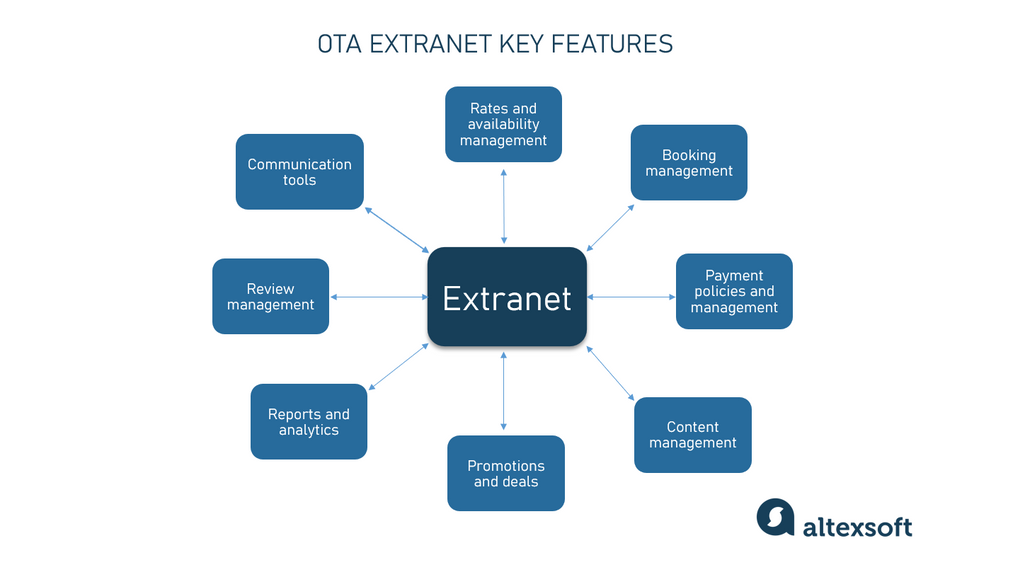
Booking extranet main features
Rates and availability (dynamic content) management. One of the key features allows hotels to manage room availability through a calendar, updating it in real time to ensure accuracy on the OTA's platform. Typically, the more rooms a hotel has available, the better its listing position.
You can hide certain room types from the listing or set rules that hide them automatically. This is useful, for example, when the demand is high, and you want to temporarily withhold the cheapest rate plans.
On the same tab of the admin panel, a hotel can set tariffs and different rate plans such as non-refundable, cancellable with full or partial refund until a specific date, or rates with breakfast included. OTAs generally favor hotels with many rate options, so those with only one fixed rate can be downgraded in search results. You can also set rules to stop selling specific rates automatically. For instance, if you have a rate that includes a bottle of wine, but the number of bottles is limited per day.
Booking management. This feature deals with the details and logistics of reservations once they are made. This includes keeping track of new, modified, and canceled bookings. It also allows for accessing and updating guest details and special requests, such as room location, dietary requirements, extra amenities, or late check-out.
Payment policies and management. You can set up payment policies through the extranet, depending on who processes payments — the hotel or the OTA. In the latter case, you can choose to receive money from the travel agency daily, weekly, or monthly. If you handle payments yourself, let guests know what payment methods you accept, be it credit cards or cash. The status of the payments can be checked via the extranet.
Another essential tab is “Policies,” where you can set cancellation, prepayment, and refund conditions, as well as house rules.
Static content management. Updating property information, refreshing the photo gallery with images of renovated rooms or a new pool, and creating descriptions specific to each OTA help attract potential guests and improve conversion rates.
Promotions and deals. An extranet lets hotels create and manage special offers, discounts, customized promotions, and packages to attract various types of travelers. These promotions can be targeted to specific dates or demographics for maximum impact. For example, you can offer a discount for early birds, last-minute deals, special rates for the low season, or a package that includes theme park tickets to attract families.
Participating in OTA loyalty programs, like Booking.com's Genius or Hotels.com Rewards, can significantly boost your property's visibility. However, keep in mind that rewards from these programs are often combined with the deals you set up. This means that if you participate in Genius, which gives a traveler a 10 percent discount, and then you offer a special 15 percent discount for early birds, you’ll end up with 25 percent less than the initial price.
Reports and analytics. Extranets offer access to reports and analytics that provide valuable insights into booking trends and hotel metrics to evaluate your property performance. By examining guest demographics and preferences data, you can understand your clients and modify the offerings to better align with the target audience's needs.
Review management. Responding effectively to customer reviews is crucial not only for the hotel’s online reputation but also because the speed and quality of your responses can impact your property's ranking on the OTA website. The extranet enables you to handle negative feedback quickly and show appreciation for positive comments.
If your hotel has an issue with fake customer reviews, read our article about fake review detection to understand how to handle this problem.
Communication tools. In addition to answering reviews, you can facilitate direct communication with guests by sending welcome messages, offering concierge services, and following up after the stay to encourage repeat bookings. Extranets allow you to set up message templates and automate delivery.
Booking extranet vs channel manager: Why do you need both?
Imagine you created a profile on Tinder. Your pics became a hit, you’ve had several dates, and life is good. But then you decide to expand your horizons and dip your toes into a couple more dating apps. Since you are busy, you delegate part of the work to your younger brother, eager to earn some pocket money. He's your new profile manager, tasked with changing your status from "Ready for an adventure" to "Taken" or "It’s complicated," uploading fresh pics, and even giving you analytics on your photo popularity.
But let's be real here. Would you trust a teenager to choose your potential soulmates or to chat with them? Who knows what kind of matches a sixteen-year-old would land you — probably someone who thinks "LOL" is cutting-edge banter. And subtle humor? Not exactly his strong suit. So you'll keep crafting those witty bios yourself, most likely different for each application.
Of course, we exaggerated a bit, but this analogy generally captures the difference between a channel manager and an extranet. Now, let's move from metaphors to practice.
If you own a small inn and are working with a couple of OTAs, everything can be done manually via extranet. However, for a larger property that sells inventory through various channels, from the hotel website and GDS to many different bed banks, TMCs, and OTAs, automation is a necessary solution; otherwise, double booking can happen. That's why most large hotels use channel managers.
This software integrates with different distribution channels via APIs to update data across all selling points simultaneously, minimizing the risk of overbooking and maintaining rate parity. A channel manager provides a single interface to control listings on all online reservation sites. When bookings are made, the PMS and connected distribution channels are immediately informed of the changes, keeping records current. This tool also tracks and analyzes the performance of each channel, generating reports with valuable business insights.
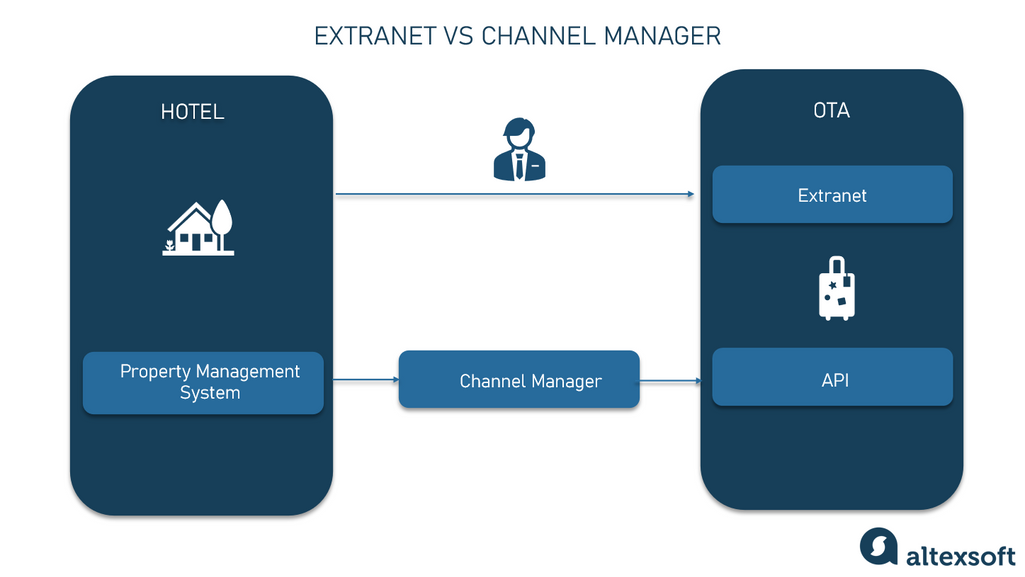
Booking extranet vs channel manager
Can a channel manager completely replace the extranet? No, it can’t. First, you can only register a new account on the OTA through the extranet. Second, not every channel manager is compatible with every extranet — it depends on the software's characteristics as well as OTA’s policies and list of pre-connected technical partners. Therefore, always check how your particular channel manager interacts with a specific OTA's extranet.
Third, even if synchronization is possible, it usually only covers basic functions provided by the extranet, such as managing your availability, rate, and content management; getting bookings; and setting up promotions.
On the other hand, extranets offer additional functionalities and unique features that help engage your target audience, communicate with clients, get market insights, and improve the hotel’s listing performance. Besides, it is only through the extranet that content and promotions can be created for one specific OTA. That’s why even a branded hotel with a modern channel manager has reasons to occasionally interact directly with OTAs’ extranets.
Main extranets and their key characteristics
When you start working with a particular OTA, you must use its extranet, and its inconvenient attributes or lack of features can hardly become a deal-breaker. However, generally speaking, the largest OTAs tend to have the most developed, feature-rich, and user-friendly extranets.
Booking.com Extranet
Mobile App: Pulse
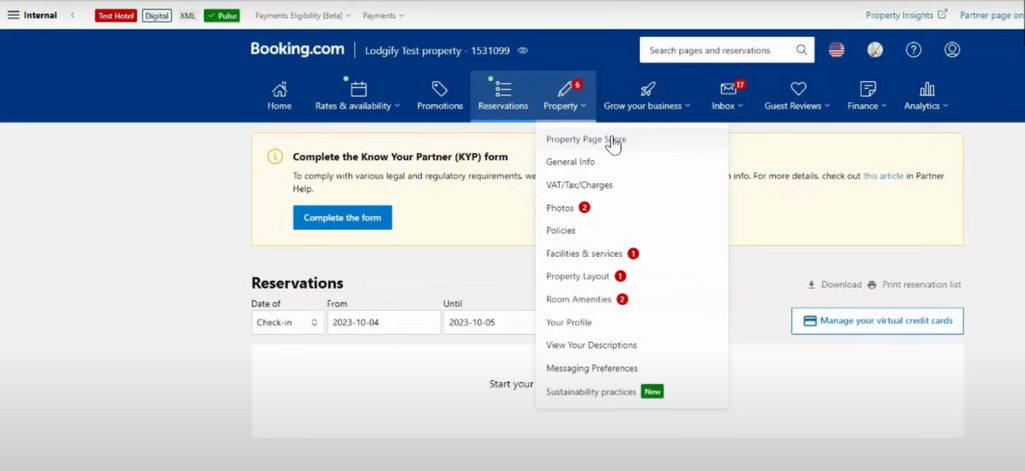
Booking.com Extranet dashboard. Source: Booking.com
Boking.com Extranet is a sophisticated, multi-functional administration panel that provides property owners with many features. For instance, you can manage opt-in programs such as Genius and Preferred Partner via the extranet. Additionally, there’s a tab called "Opportunity Center" that makes suggestions to improve your listing's performance.
Booking.com partners with many channel manager providers. If you deal with one of them, in addition to standard availability, rate, and content management, you'll be able to set up promotions and read guest reviews (but not answer them) without logging in to the extranet.
A detailed guide to the Booking.com Extranet can be found on the Partner hub.
Expedia Partner Central
Mobile App: Expedia Group Partner Central
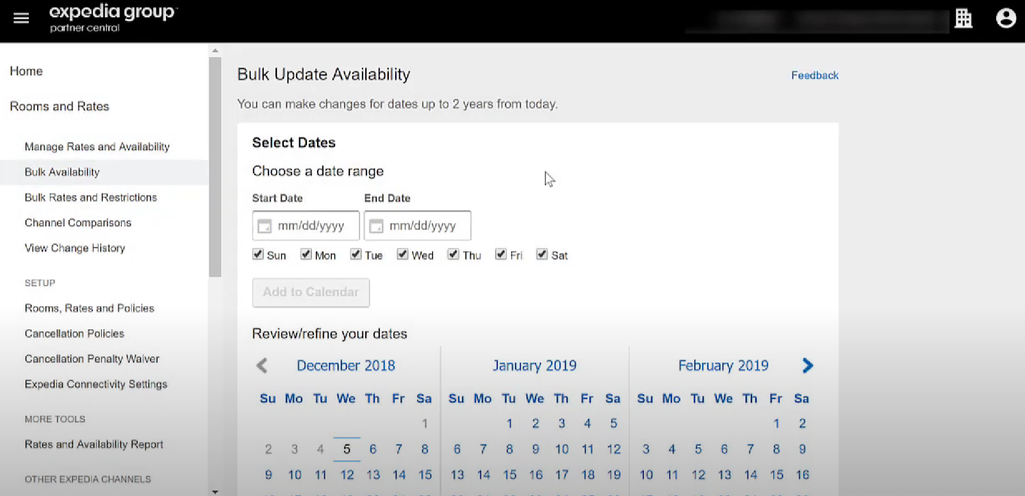
Expedia Partner Central dashboard. Source: Expedia
Expedia Partner Central enables hoteliers to manage their listings across all of Expedia Group’s online booking platforms, such as Expedia, Hotels.com, Vrbo, Travelocity, etc. Through the same extranet login page, you can also access the Expedia Travel Agent Affiliate Program (TAAP).
The particularly beneficial feature of the Expedia extranet is Rev+, which provides metrics like average daily rate (ADR) and occupancy rate, closest competitive rate comparisons, and rate recommendations. You can also join and manage TravelAds, Expedia’s pay-per-click advertising, via the extranet. It’s possible to target domestic or international customers and set specific dates, as well as a budget and maximum cost per click.
Airbnb Host Dashboard
Mobile App: Airbnb
Airbnb, the largest vacation rental platform, doesn't have a dedicated extranet login page. You can access the Airbnb Host Dashboard from your user profile on the web, desktop, or mobile version of the site by selecting the “Switch to hosting” option. It will appear in your profile after you register your property on the Airbnb platform.
In addition to the usual reservation, payment, and message management features, key functionality includes the Insights tab, where you can see an analysis of vacation rental trends in your area, performance reports, and tips on how to boost your booking. You can also connect with the Hosting community through the host dashboard to exchange hosting advice.
Agoda Yield Control System
Mobile App: Agoda YCS
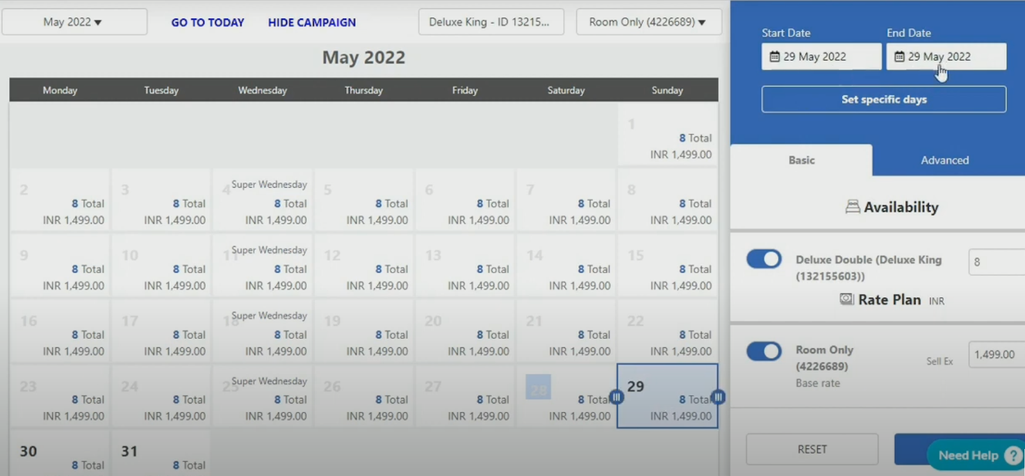
Agoda Yield Control System dashboard. Source: AYCS
Although the Agoda platform, targeting consumers in the Asia-Pacific region, is a subsidiary of Booking Holdings, it has its own extranet, called Agoda Yield Control System, that has extensive functionality. As for the marketing tools, the hotel can activate the Growth Program to maximize revenue and increase visibility. Joining the Agoda Intelligence program will automatically adjust rates with a dynamic pricing model that tracks and adjusts to market changes. A detailed guide to the Agoda YCS can be found on the Partner hub.

Olga is a tech journalist at AltexSoft, specializing in travel technologies. With over 25 years of experience in journalism, she began her career writing travel articles for glossy magazines before advancing to editor-in-chief of a specialized media outlet focused on science and travel. Her diverse background also includes roles as a QA specialist and tech writer.
Want to write an article for our blog? Read our requirements and guidelines to become a contributor.

